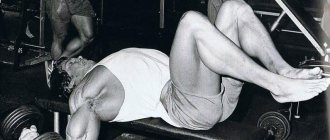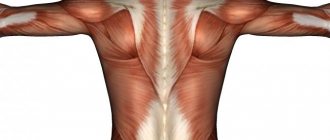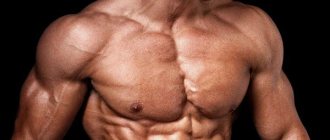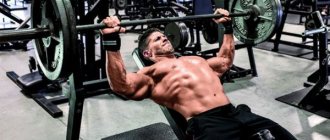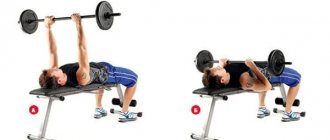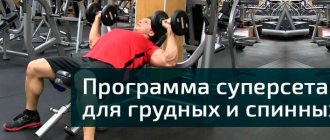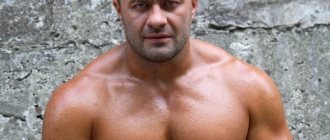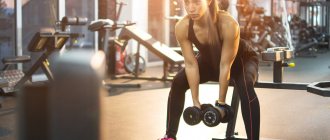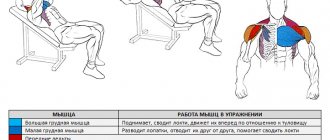Share:
What you need
- dumbbells
The Arnold press is a popular basic exercise for developing the deltoid muscles. As you can guess from the name, it came into widespread use thanks to Arnold Schwarzenegger, who built his entire shoulder training around it. This exercise has its advantages relative to the classic seated dumbbell press. For example, it more strongly involves the middle bundle of the deltoid muscle into work, due to which the shoulders become more voluminous.
Today we will figure out how to do the Arnold press correctly and how to use this exercise in your shoulder training.
What muscles does the Arnold press work?
The main task in the Arnold press is to develop the muscles of the shoulder girdle. Namely:
- Deltoid muscles. It is this press that puts a lot of stress on the front head
(initial phase).
Then it shifts to the middle head
(middle phase of execution).
And in the end, although small, the load goes to the back head
(shoulder stabilization in the upper phase). - Rotator cuff muscles. This is a group of muscles that are responsible for rotating and stabilizing the humerus. It includes: supraspinatus
,
infraspinatus
,
subscapularis
and
teres minor.
In addition to the main muscles, there are secondary ones. Who also take part in the movement. This:
- Triceps . Extends the arm at the top of the exercise.
- Coracobrachialis muscle. Responsible for flexing and adducting the shoulder to the body. That is, it actively works when returning to its original position. It also holds the humerus in the joint.
When performing the Arnold press standing, not sitting. Additionally, the muscles responsible for stabilizing the body will work.
- Press
- Back extensors
- Gluteal
- Thigh muscles (anterior and posterior groups)
- Calf muscles
This entire muscle army will serve us when performing this exercise.
Advantages and disadvantages
Advantages
- In this press, the front head of the deltoid muscles is constantly under tension. This contributes to its better development.
- Helps give the shoulder muscles a more expressive shape.
- This press helps strengthen the rotator cuff muscles. Due to rotation in the shoulder joint and working with light weight.
And that, unfortunately, is all. And then the question immediately arises, how is this possible?? After all, this exercise was performed by Arnold Schwarzenegger himself, it cannot have so few benefits. In fairness, it is worth noting that his shoulders have never been his strong point. There was a particular lack of development in the middle beams. From this we can conclude that there were some flaws in the training of the eight-time Mr. Olympia. Of course I don't presume to condemn him. Because he is truly the greatest athlete. And during certain training periods, the Arnold press may even be appropriate. For example, when preparing for competitions or during drying to give them relief. But unfortunately, it is not suitable for everyday training.
Flaws
- With poor technique and incorrectly selected dumbbell weights, you can easily injure the rotator cuff muscles. They are especially vulnerable at the moment of abduction and rotation of dumbbells from the initial position to the middle one.
- A very large load falls on the front head. And since she already works in a large number of basic exercises. Starting from: DUMBELL PRESS and ending with Push-ups. There is no point in doing additional exercises for it. On the contrary, this may overwork this head. And cause injury.
- By performing the Arnold press, we will not be able to build muscle mass. Since this exercise is more aimed at giving relief.
- The exercise is not suitable for beginner athletes. Since there is a high risk of injury and very little return in muscle growth.
That is, to summarize the above. This can be concluded. That Arnold's bench press does not live up to the hopes that most athletes place on it. And most likely it is still popular, since it is named after the idol of most builders. But it is still worth considering the fact that during certain training periods this exercise can be effective. And to slightly reduce the risk of injury, you should leave room for it at the end of the workout and take light weights.
Training principles
- The main exercise of the bodybuilding legend was the barbell press on a horizontal bench. He performed this exercise in different ways, using different grip widths, sometimes using extreme weights, but mostly he worked in the usual mode for bodybuilders.
- Schwarzenegger also paid great attention to pumping. These methods and training regimens were applicable not only to pressing techniques, but also to other exercises of the training process aimed at developing other muscles.
- Most of the training was based on the “pyramid” principle. In this training scheme, the athlete started with a light weight and reached the maximum, gradually reducing the number of repetitions. And after reaching the peak of the load, he “descended in weight” down.
- The athlete also used dropsets, dropping the weight on the last approaches and continuing to perform the exercises without rest between approaches.
- Arnold performed five sets of each chest exercise. This included a warm-up approach.
- The bodybuilder used mixed training, in which he managed to combine both strength training and one aimed at muscle volume.
Arnie's maximum bench press weight was more than 240 kilograms. By the way, Schwarzenegger considered fixing the elbow joints in a non-extended state to be an important point in working with heavy weights, that is, the arms in the elbow joints should not be completely straightened. Firstly, straight arms are a risk of injuring the joints, and secondly, it minimizes the load on the triceps.
Arnold press technique
Most often, the Arnold press is performed while sitting on a bench. This gives an additional point of support. That is, we rest our feet on the floor and sit with our pelvis on the bench. Athletes who want to unload their backs can additionally rest against the back of a bench set at an angle of 80-90°. The exercise itself consists of 3 stages. Pulling the elbows to the side, turning the dumbbells and the bench press itself.
Initial position:
- Go to the bench press. If you need a backrest, then raise it to the desired height.
- Take dumbbells of the desired weight in your hands and sit down. Press your shoulder blades firmly against your back (when working without it, keep your back straight). Bend your lower back slightly.
- Spread your legs wide and place them on the floor.
- Curl your arms with the dumbbells as if you were doing a BICEPS CURL. Palms face back.
- Raise your elbows slightly upward until you feel tension in the front head of the deltoids.
Performance:
- As you exhale, we begin to move our elbows in different directions from the bottom point. And at the same time, turn the dumbbells counterclockwise. Until the palms point forward. And without pausing, press the dumbbells up in an arc. That is, at the top we bring them together a little.
- While inhaling, we return to the starting position. Doing the same thing, only in reverse order. We lower our hands down, bring our elbows together while simultaneously rotating the dumbbells clockwise.
At first, the exercise will seem difficult, and you will sometimes get confused. But after just a few approaches, your neuromuscular connection will strengthen and the movement will become familiar. The main thing is not to rush. The main goal of the exercise is to feel the work of each head of the deltas. And perform the movement by reducing them.
Arnold biceps workout
What was the secret to building Arnold Schwarzenegger's legendary biceps peak?
“I've had to discuss the techniques I used to build biceps peaks so many times that the information no longer feels like a secret: supination, turning your wrists outward when lifting dumbbells (with a barbell you physically can't do this movement).
Supination causes the outer head of the biceps to tighten further, thereby increasing the peak and adding additional mass to the area of the arms that is especially visible in the rear double biceps pose. When performing any type of dumbbell lift (standing, sitting, lying down, or concentrated), start with a neutral arm position, and as you perform the lift, rotate your hands so that at the top of the trajectory your palms are facing up.
At the moment of full contraction, rotate your palm so that your index finger is higher than your thumb and further tighten your biceps. The pain from contracting the muscles can be very intense, but it is worth it. Stick to this technique for every rep of all dumbbell curls, and it will make a significant difference in your arm development in the long run.
In addition to supination, I like to have the dumbbell follow the stroke of the wrist to provide a stronger contraction of the biceps. Most people begin biceps exercises with their arms straight and then bend their wrists toward their shoulders as the bar rises.
Thus, part of the force of gravity is neutralized and the essence of the final part of the movement, in which the maximum contraction is created, is lost.
So when I did bicep curls, I allowed the barbell or dumbbells to rest on my fingertips, thereby extending the wrist with each rep rather than bending it or holding it straight, which is what you see most of the time. Thus, at the top point of the amplitude, the weight was not supported by tension in the forearms, but the entire load went into the biceps, allowing them to truly contract.
| Exercise | Approaches | Repetitions |
| Standing barbell curls | 5 | 6 — 8 |
| Alternating standing dumbbell curls | 5 | 8 — 10 |
| Barbell curls on a Scott bench | 4 | 8 — 10 |
| Concentrated curls | 4 | 10 — 12 |
Arnold Press
Performing a standing Arnold press will make the exercise more multifunctional. By engaging the muscles of the back, legs and abdomen. Which will provide stability to your body and will receive a static load. But unlike the sitting option, you will have to focus not only on the movement itself, but also on stabilizing the body. And if you take into account the fact that the Arnold press already requires good coordination. We can conclude: only professional athletes can perform this option correctly. The main thing when performing while standing is not to turn the exercise into throwing dumbbells by pushing with your legs. This will turn the exercise into a kind of shvung. And the risk of shoulder injury will increase.
Learn new variations with dumbbells
While Arnold preferred barbells in the gym because of the heavier weight he could lift with them, he knew the benefits of dumbbells. “I experience a greater stretch when working on dumbbell pecs, most notably in the incline movements. Dumbbells allow you to lower your arms deeper than is possible with a barbell,” he noted.
Dumbbells allow you to work your muscles through a wider range of motion, but be careful and try to avoid significant stretching of the shoulder joints at the lower end of the range of motion.
In the next article in the series, we will look at tips for pumping up your back from Arnold Schwarzenegger.
Arnold One Arm Press
This is a very rare option. It is mainly used for restoration purposes. Also, working with each hand in turn, we will load the oblique abdominal muscles. Which will prevent the body from tilting towards the working arm. To be honest, I don’t see any particular advantages in this option. Since the exercise will take much longer to complete. And these costs are not so justified. But if you have a desire, you can try it in action.
Recommendations for implementation
- Movements should be under your strict control. Don't let your shoulders drop down due to inertia.
- Don't get too hung up on rotating the dumbbells. When you begin to move your elbows to the side from the starting position, your forearm will automatically begin to rotate in the desired direction.
- In the middle phase of the exercise, make sure that your elbows are in the same plane as your body (not moving forward or backward). This will allow maximum use of the middle head.
- When performing a standing press, do not help yourself press the weight by swinging. This may cause spinal injury.
- At the top point, do not straighten your arms completely. This will take the load off the deltoids and can overload the elbow joint.
Basic mistakes when performing the exercise
Too much dumbbell weight
As trivial as it may seem, it is the use of inappropriate weight that causes violation of technique and serious injuries. I don’t know why, most athletes forget about this. As for this exercise, the working weight should be much less than in classic bench presses. By about 30%. This is of course not an exact number. But it's perfect as a guide.
Strong arch in the lower back
This error stems from the first one. Athletes take large dumbbells in their hands, but they cannot squeeze them by contracting the deltoids. And in order to cope with the weight, they begin to sag in the lower back. This makes it possible to involve the pectoral muscles in the work. Which of course greatly simplifies the exercise. As a result, its effectiveness suffers and the deltoids do not receive the necessary load. But this is not the worst thing! This technique greatly overloads the spine, putting it in a very dangerous position. Consequently, over time, we can become seriously injured.
Low elbows at the starting point
When performing the Arnold press, the main task is to keep the deltoids under tension at all times. To do this, we bring our elbows forward in front of the body to load the front head. If you lower them lower, almost to the same level as the torso. The entire load will shift to the biceps. In this case, the dumbbells will have to be lifted from a dead center. And if at the beginning of the approach we will be able to do this with ease. Then towards the end, you will have to resort to cheating. And in order to squeeze the weight, we involuntarily begin to sway. In this case, the dumbbells will simply be thrown up in a big way. This technique can easily injure the muscles of the shoulder and rotator cuff.
Iron Arnie's Tip: Use Multiple Angles to Train Your Pecs
Arnold used multi-joint compound moves in his chest routine that bombed his pecs from different angles. I realized that the set of exercises should be basic and very heavy,” he said. Basic, for Arnold, meant working the pecs on a flat, incline bench with positive and negative angles, while sometimes training like a powerlifter, rather than trying a variety of machines or using trendy methodologies. Arnold saved pumping approaches for the final stages of training in the gym.
Tips for maximum efficiency
- Before starting your workout, be sure to do exercises to warm up your entire body. Pay special attention to the shoulder joints and neck. To warm up, you can use the usual exercises that you remember from physical education lessons.
- If you experience pain or discomfort during exercise. You should stop the exercise immediately.
- In order to increase the load on the middle head. In the middle phase (elbows moving to the sides), you need to tilt your hands slightly inward. This will shift the center of gravity slightly. This technique was used by the very first Mr. Olympia Larry Scott.
- Before performing working approaches, do 1-2 warm-up approaches with light weight.
- It is best to perform the Arnold press at the end of your workout. Using light weight and performing the exercise in an average number of repetitions. Approximately 4 sets of 12-15 reps.
- At the end of your workout, be sure to do a small set of muscle stretching exercises.
Unfortunately, the Arnold press is not effective. Yes, with its help you can slightly improve the relief of the deltoid muscles. But due to the complexity of the movement itself, it is better to choose other isolated exercises for this role. So, whether to do it or not, the decision is up to you. The main thing is not to forget about the technical points that will help you avoid injuries. If you have something to say about this bench press, I will be glad to read it in the comments.
Good luck to everyone in your training!
Features and nuances of the training
Arnie also used parallel bar push-ups to train his pectoral muscles. He did this exercise with impressive weights, but the technique in his training was somewhat different than what we were used to. He performed push-ups at two-thirds of the amplitude with his body twisted forward. By the way, to emphasize the pecs, the best option would be parallel bars with wide handles.
Also, in each workout of the pectoral muscles, Schwarzenegger used stretching exercises, namely dumbbell lateral raises and pullovers. Moreover, he claims that you need to work in these exercises only with a large working weight and in the range of 12-15 repetitions. Perhaps Arnie is right, and this exercise in this mode is a truly highly effective way to develop the pectorals, but you still need to be aware that these exercises are very traumatic.
In Schwarzenegger's training, the main role was played by the use of different techniques, and not by the number and variety of exercises. This bodybuilder knew what he was doing, and therefore achieved unprecedented heights!
